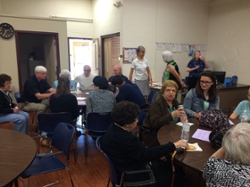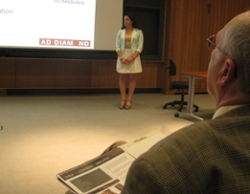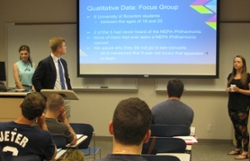Classroom Projects for Area Nonprofits Benefit More Than the Client

Several spring semester classroom projects for area nonprofit and community organizations have placed students directly in the local community and resulted in a “win-win” for all involved. Professors have motivated and engaged students. Local organizations receive learned expertise. Students gain resume-building, real-world experience. And, area residents benefit from improved programming and communication from area organizations.
Among the community projects used in courses during the spring semester at the University were a multimedia communication presentation focused on local history for an advanced journalism course, an advertising campaign project for a museum for an advertising class, and a marketing project for an orchestra for a consumer behavior class. These courses highlight just some of the many classes at the University that include a community project component.
News Reporting (COMM 320)
Students in the News Reporting course taught by Kimberly Pavlick, Ph.D., assistant professor of communication, were required to produce a multi-media pieces that look at the history of West Scranton, profile of a member of United Neighborhood Center’s West Side Active Adult Community Center, and address a subject discussed by the active adult in his or her profile interview. The students’ course work involved learning and using multi-media technology, writing and historical research.
The students’ multimedia presentations, “Sharing Life Stories of West Scranton,” was premiered at a community event in May.
“The students loved it. They became engaged in the project as they began to meet the participants from the active adult center,” said Dr. Pavlick, who also noted that the older adults “connected with and embraced” the students. “They liked knowing that the students were interested in their stories,” she said.
Laura Fay, a senior from Thornton, said she not only learned how to conduct an interview and report a story – but also how to determine the “best platform to use for the piece.” She produced a video interview and blog about a West Scranton resident, as well as slide show with a voice recording focusing on the “religious roots” of West Scranton.
Fay also thought the project was “special in the sense that it put us (students) out in the community. We had to talk to people outside of the University.” Fay noted that she thought the local focus of course was also unique in that it required students to learn specifically about the history of West Scranton, unlike many other courses that take a more global perspective with projects.
The class-based activity is part of a broader Scranton Neighborhood Park Collaborative project, of which The University of Scranton is a member, that is using the humanities as part of a process to revitalize city parks, beginning with West Scranton. The collaborative project is supported in part by the Pennsylvania Humanities Council, the Federal-State Partner of the National Endowment for the Humanities.
Advertising COMM 225
Students in the Advertising course taught by Stacy Smulowitz, Ph.D., assistant professor of communication, were assigned the task of creating an advertising campaign to increase visitors to Anthracite Heritage Museum in Scranton. The semester-long group project incorporated conducting primary consumer research via focus groups, surveys and observations. The research was completed by each of the groups, however the results were shared and used by all the students in the course. According to Dr. Smulowitz the research was intended to provide the basis for creating a comprehensive advertising campaign for the museum. The campaigns included SWOT analysis, setting campaign objectives, messaging, creative, media planning, scheduling and budgeting, and suggestions for monitoring and measuring results.
At the end of the semester, the students presented their plans to Chester Kulesa, historic site administrator for the Pennsylvania Historical and Museum Commission. He saw many benefits from the students’ efforts.
“First, the project is like putting light through a prism. It provides a different perspective – different and fresh opinions – on what we do,” said Kulesa. “It also brings in expertise that I don’t have. This is research that I would not have done.”
“We are very fortunate to have recourses in our community – such as the colleges and universities - that we can take advantage of to improve our organizations and allow us to better fulfill our missions,” said Kulesa.
Kulesa also said the plans presented offer some “real opportunity for implementation” that he will discuss with his staff.
One campaign presented by University juniors Amelia Cheikhali of Bethpage, New York, Elizabeth Hamm of Brooklyn, New York, and Karen Mennella of Mahwah, New Jersey, chose as its theme “Dig Down” – a phrase that works well with the museum’s coal mine theme and supports the students’ research that discovered consumers would view the attraction favorably once they become more aware of the venue and its offerings. In other words, once they “dig down” into the information.
Consumer Behavior – MKT 362
Abhijit Roy, Ph.D., professor of management, marketing and entrepreneurship, gave students in his Consumer Behavior course a choice of projects for which they were to develop marketing proposals. Among the choices was a “real life” project to attract millennials to NEPA Philharmonic concerts.
The marketing proposals were to be based on primary and secondary research gathered by the students. At the end of the semester, students selecting the project for the orchestra presented their plans to Patricia Arvonio, director of administration for the NEPA Philharmonic.
The proposal presented by University juniors Susan Kitcho of Avoca, Cory McPherson of Chester, New Jersey, and Dana Netel of Monroe, New York, suggested targeting students attending college at campuses in Scranton. Their proposal also recommended the use of social media and YouTube postings, among other promotions, to increase awareness of the concerts for this target audience.
The three students agreed the idea of helping out a local organization appealed to them.
“There was added pressure from doing a ‘real-life’ project, but it was good stress,” said Kitcho.
“It’s motivating to know that someone will be in the room listening to your plan,” said Netel.
None of the students chose the project to “build a resume,” but they did realize merit of being able to say they worked on a “real” project for a “real” organization.
Chester Kulesa, historic site administrator for the Pennsylvania Historical and Museum Commission, listens to an adverting campaign pitch from Amelia Cheikhali as part of a class taught by Stacy Smulowitz, Ph.D., assistant professor of communication.
From left, University Students Susan Kitcho, Cory McPherson and Dana Netel present their marketing proposal for the NEPA Philharmonic as part of a consumer behavior class taught by Abhijit Roy, Ph.D., professor of management, marketing and entrepreneurship.
From left, University students Karen Mennella, Elizabeth Hamm and Amelia Cheikhali present their advertising campaign proposal for Anthracite Heritage Museum in Scranton.


